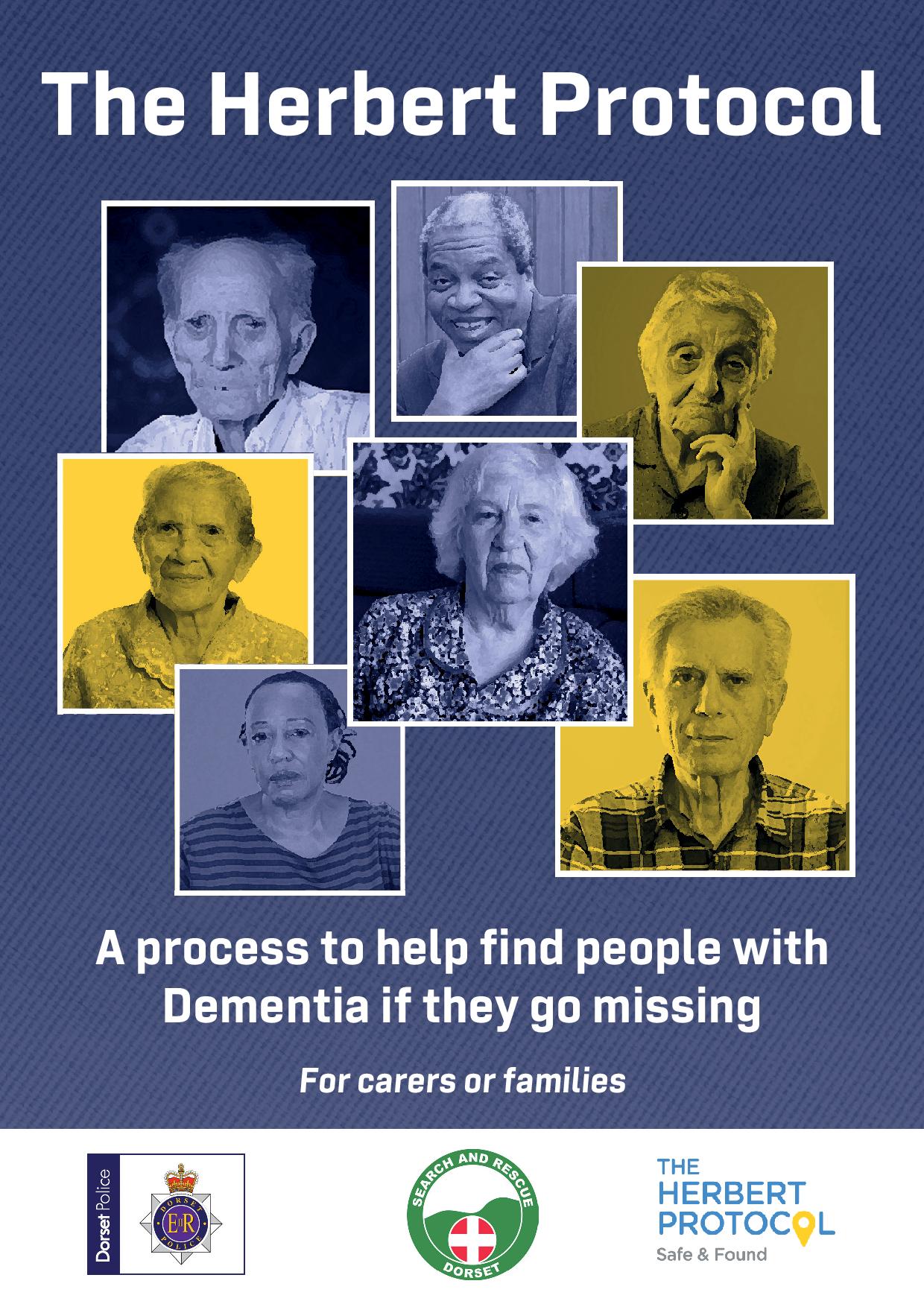Herbert Protocol - Missing Person with Dementia
PREPARATION ~ PREVENTION ~ PEACE OF MIND
Dorset Search and Rescue (DorSAR) is proud to support Dorset Police with the promotion of the Herbert Protocol. The 'Herbert Protocol' gives nationally recognised branding to our the original 'Safe and Sound' Initiative, When a person goes missing, it is very distressing for family and friends and can be even more worrying when the missing person has dementia.
The Herbert Protocol is a simple risk reduction tool to help the police in their search for people with dementia who go missing. It encourages carers or family members of adults living with dementia to collate information on those who are vulnerable on to the Herbert Protocol form, which can be given to the police if they go missing.
The initiative is named after George Herbert, a war veteran of the Normandy landings, who lived with dementia. He died whilst 'missing', trying to find his childhood home.
If you believe a person has gone missing and are concerned for their safety, call the police on 999 and tell the police operator that you have a Herbert Protocol.

What do I put on to the Herbert Protocol form?
It contains a list of information to help the police if the person goes missing, including:
- medication required
- mobile numbers
- places previously located
- a recent photograph
You'll find the form in the documents list on this page.
Keeping a completed form saves the worry of trying to recall the information during the stressful time of someone going missing. It also saves time for the police, allowing the search to start sooner and the information to be gathered at the time. It should be kept up to date with a recent photograph of the person, to be passed to the policed if needed.
Resources
The following resources are aimed at families and carers. Please consider downloading the posters or flyers to raise awareness of this national scheme. You may download the form to complete in either Microsoft Word or PDF format.
When should a form be filled in?
If you are a carer, you should use your professional opinion to judge when to complete a form. If you’re a family member, you should use your knowledge to decide whether a person is at risk of going missing. Remember, having this information ready to provide can save worry and time if someone goes missing.
Who completes the form?
The form can be completed by a family member or, with the permission of the next of kin, friend or neighbour working together with the vulnerable person.
If the person is in a care setting, or the person filling in the form is a home carer or a representative of a partner agency, take advice from your management on your organisation's protocols.
The form should be completed and regularly updated so that all the information is as relevant as possible.
When should the form be given to the police?
The police only need the form at the point the person is reported missing.
There is no need to hand it to police before then and the form will be returned once the person is found.
Where should the form be stored?
It should be stored securely, but where you can find it quickly.
In a care setting, the information must be stored in accordance with data protection legislation. Please make sure you tell anyone else who needs to know where it is, including other relatives, friends or carers.
You can download the form and print it off, but you will need a paper copy to hand to the police officer attending to take the missing person’s report.
What if the person goes missing?
If you discover a person is missing, conduct a brief ‘open door’ search of the address, grounds and outbuildings, to see if you can find them.
If they're still missing, call 999 immediately. Don't worry - you won't be criticised for calling the police if you are concerned about a person's safety. The sooner the police know someone is missing, the sooner officers can start looking for them.
When you ring the police, tell them you have the Herbert Protocol profile available.
When the Clocks Change, Take a Photo of Your Loved Ones
Few people realise the benefits of having a recent, clear, head and shoulders photograph of the people they love and care for in the event that they unexpectedly wander off and go missing. This is one way that Carers and parents can remember to take a 'head and shoulders' photograph of the person(s) they care for and/or their family members and paste onto the life history questionnaire. This will ensure that the photo on the questionnaire is never more than six months old. Don't forget to check the smoke alarms at the same time!
These easy actions will help you and the ones you care for stay safe and sound in the event of an emergency.
We are always interested to work with other agencies and groups that share a concern for the safety and welfare of vulnerable persons. If you have a related campaign or ideas for potential joint initiatives please get in contact with us to discuss potential partnerships.



